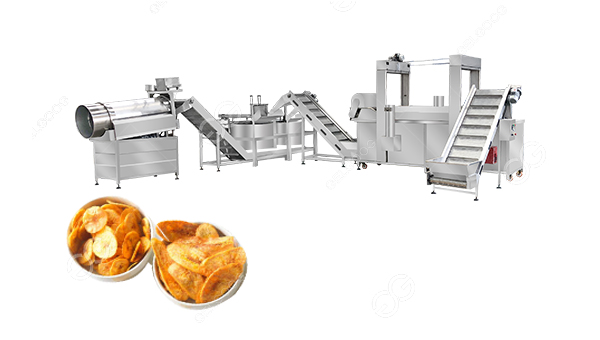Banana chips have become a popular and delectable snack enjoyed by people around the world. Whether sweet or savory, these crispy delights are a result of a meticulous and fascinating processing journey in the factory. But how are banana chips processed? In this article, we will show you the banana chips production process.

Harvesting and selection:
The journey begins in the banana plantations, where green bananas are carefully harvested. The selection process is crucial, as only high-quality bananas with the right degree are chosen for the chip-making process.
Blanching:
The first step in the factory involves blanching the bananas. Blanching helps in loosening the peel, making it easier to remove. The bananas are immersed in hot water for a short period, and this heat treatment also plays a role in preserving the color and flavor.
Peeling and slicing:
Once blanched, the bananas are ready for peeling. The peeling process can be done manually or through automated machinery, depending on the scale of production. After peeling, the bananas are sliced into thin, uniform rounds using precision slicing equipment.
Pre-treatment:
The banana slices are then treated to prevent oxidation and maintain their appealing color. This pre-treatment step usually involves immersing the slices in a solution containing citric acid or other antioxidants.
Frying:
Frying is a critical step in the banana chip-making process. The banana slices are carefully lowered into hot oil, where they undergo a transformation from soft and pliable to crispy and golden. The frying time is crucial, as it determines the texture and color of the final product.
Deoiling:
After frying, excess oil is removed from the banana chips through a deoiling process. This step is essential to ensure the chips have the right level of crispiness and are not overly greasy.
Flavoring and seasoning:
At this stage, the banana chips are ready to receive their flavor. Seasonings, such as salt, sugar, or various spices, are applied to the chips. This step adds the perfect balance of taste to the crispy snack.
Cooling:
To set the final texture and prevent moisture retention, the banana chips undergo a cooling process. The chips are allowed to cool down gradually, ensuring they maintain their crispy texture and do not become soggy.
Packaging:
The final step involves packaging the banana chips into various-sized bags or containers. This packaging not only protects the product but also ensures that the chips remain fresh and crispy for an extended period.
The journey of banana chips from the banana plantation to the snack aisle is a captivating process that combines technology, precision, and expertise. Each step, from harvesting to packaging, plays a crucial role in delivering the irresistible crunch and flavor that makes banana chips a beloved snack worldwide. If you want to start the banana chips business, and need banana chips production line, contact us now.